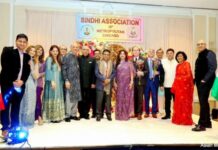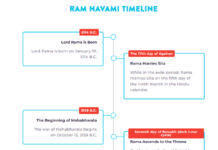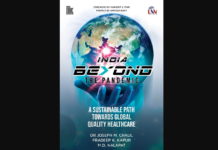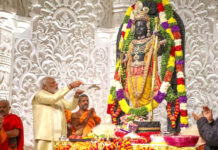
CHICAGO: Anila Sinha Foundation (ASF), an Illinois based no profit organization that promotes classical Indian dance Kathak in this part of the world, did it again – organizing International Kathak Festival in league with University of Chicago.
The three days festival beginning Friday September 12 was the third of its type and it could have been an affair to remember for many years but for the visa problem that came in the way of Kathak artists coming inform India. This was an unwholesome experience again for ASF and many Indian Americans here felt the matter should be taken up at the highest level since that denying visa to the deserving artists for performance here smacks of incompetence or indifference on the part of concerned officials.
This third festival could also boast of having globally renowned artists like Pandit Birju Maharaj and Saswati Sen participating in the workshop and presentations. A very well known dance critic, Sunil Kothari had also come to lend credence to the festival.
Indian Consul General Dr Ausaf Sayeed opened the three-day festival with a brief address. He underlined the storytelling aspect of Kathak going back to the epics and its composite culture of foreign and indigenous elements. Emcee Shobha Sinha welcomed the audience by reminding of ASF’s mission especially with regards to education. IH Program Director Denise Jorgens underlined how the festival furthered IH’s role of facilitating exchanges among international students and their cultures.
Sunil Kothari, who has authored a book on this dance form, introduced the first panel on Kathak’s history and the particularities of diverse gharanas.
Sunil mentioned about Birju Maharaj’s huge contribution to the classical form of Indian dance – Kathak. He grew up with the advantage of knowing Sanskrit (and Hindi) very well. A critic should have discerning ability to recreate artistic performance through his writing.
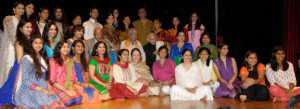
The festival featured morning scholarly panels, afternoon workshops and evening performances. Dance groups came from across North America and all the way from India. All the three major traditions, including Jaipur and Banaras gharanas were properly represented at the event but the Lucknow school seemed pre-dominant.
Pandit Birju Maharaj kicked off the first panel discussion by presenting in Hindi and English the history and distinctive features of his Lucknow gharana.
Evenings were devoted to dance and music, with Maharaj performing on all three days in choreography, solo vocal and drum ensemble. His towering personality however, dwarfed others and incidentally the first panel was largely devoted to his personal and formative years that even had touched upon renowned family members – Lacchu and Shambu Maharaj.
It was very refreshing to listen to Mekhala Natawar, a non-Indian in Jaipur, pointing out that the patronage Kathak by the Nawabs had both effeminized and Islamized the originally martial epic style. The original form would be exhibiting complex footwork and compositions associated with the Rajput courts and Hindu storytelling (kathaka).
Lucknow and Jaipur Gharanas were very aptly mingled by Richa Jain from Delhi, whose father professed Lucknow style and the mother Jaipur dance-lineages, in her beautiful performance. At the panel, she demonstrated the predominance of pakhwaj bols and gestures (hastak) in Jaipur. Upcoming young dancer Anuj Mishra from the Banaras gharana, performed “Shiva Vandana” first in pacific then in the usual Tandav mode. He went on to perform Lucknow compositions.
Prerana Deshpande from Pune in her solo performance, Jai Jai Mahadev” also blended Jaipur and Lucknow gharanas. Manjiri Vaishampayan accompanied by tablist Raj Deshmukh represented the Jaipur-Atrauli gharana with bhajans. Khayal in rag Lalita Gauri in Jhap / Teen tal, followed by bhajan “Vitthala Narahari Gopala” in rag Vibhas (in shuddha dhaivata mode)
Saswati Sen, the foremost disciple of Maharaj, demonstrated through her own dance repertoire an ideal blend. Maharaj was omnipresent throughout the performances, singing or dancing solo, participating in a percussion ensemble, or through group dances he had choreographed, especially the award-winning dance from Kamal Hasan’s movie “Vishwaroopam” rendered in Tamil, Telugu and Hindi.
Another panel was devoted to choreography, may be a somewhat foreign concept to Indian dance. The consensus was that the “open-endedness” of Kathak had enough room for experimentation and innovation. Prof. Purnima Shah noted that not a single Indian institution teaches choreography, unlike in the U.S., where it is compulsory whatever the dance form.
She delved into the specific worldview and sensibility underlying Indian classical dance and the challenge faced by Diaspora youth in sensitively rendering those culture-specific feelings (such as pining for the beloved) and self-perceptions, and not only with regards to gender differentiation
Anuradha Nag of Tarangini School of Kathak Dance choreographed “Khoj” on the Gopis pining for Krishna in Vrindavan that culminated in a Lucknow Tarana.
Lucknow style “Milan” was based on Tchaikovski’s Nutcracker and Swan Lake. Kiran Chauhan of ASF performed “Divanage” based on a collage of Sufi songs on yearning for union with God, with touches reminiscent of dervish whirling and flamenco.
Saswati Sen presented a solo based on a composition of Birju Maharaj invoking Lord Krishna and and sung by him. Ahalya Uddharan from Ramcaritmanas served as opportunity to display her skill in abhinaya.
Prashant Shah, disciple of Gujarat based Kumudini Lakhia who is now in New York teaching dance, described how he had to grapple with choreography and demonstrated the judicious exploitation of space in his gentle expressive number, in quite contrast with the breathtaking whirls of Mishra’s tandava.
Discussion on the significance of the belled anklet, costume and language, continued into a debate about Bollywood which many believe has debasing influence on Indian art forms including Kathak.
Janaki Patrik’s Kathak-style movements and postures seamlessly choreographed to a Mozart symphony had the under current of overture to Western ballet. Anuradha Nag’s Tarangini School of Kathak Dance likewise choreographed Lucknow-style “Milan” to extracts from Tchaikovsky’s Nutcracker and Swan Lake, where the dancers seemed to alternate between ballet and Kathak.
Shambavi Dandekar, exponent of Gopi Krishna’s Banaras gharana, concurred as a non-rebellious representative of the younger generation, “I’ve had so much freedom within the tradition,” she declared. A dancer-anthropologist, Prof. Pallabi Chakravorty, talked about the role played by Muslim courts in preserving the art and spoke in favor of “fusion” as opposed to rigid conservatism.
She especially contributed fruitful insights on choreography that received much applause.
Interestingly, quite a few performances demonstrated strong Islamic ethos, such as Janaki Patrik’s exposition of Ghalib’s Urdu ghazal and ASF’s “Sufiana” with its Arabic-sounding music and circular movements recalling dancing dervishes. Jain too performed compositions of Sufis Amir Khusrau and Baba Bulle Shah. The problem remains that the contemporary “Islamic” face of Kathak was being performed here almost entirely by Hindus. Is there any future for an “Indo-Islamic” aesthetic that wins significant ideological and artistic adhesion from Muslims?
The question-answer session turning into quiz format was conducted with huge enthusiasm by Saswati Sen. Most participants were student girls but a few adults too participated. Kothari elaborated on the role and importance of the informed critic in the practice of art. Sen, Patrik and Anuradha Nag recounted valuable insights based on their respective teaching, especially to students from the Indian Diaspora. A non-Desi, Patrik teaches only Indian students.
It was strongly suggested that streamlining and codifying of a standardized teaching practice would go a long way in helping the students and the dance lovers.
Had the 10 or so missing Indian dance exponents, including the otherwise very present Lakhia, received their visa-clearances, it would have further upended this veritable festival for both eyes and ears over three full days.
Dr Birendra Sinha president ASF was taken suddenly ill and could only attend the ending session. Though not present physically his presence was felt through out the three days of festival and more so when he contributed handsomely for the establishment of an endowment at the University International House for promoting Kathak thru hosting festivals and other means,
In his brief address he expressed thanks to participants, emcees, sponsors the International House for logistic support and especially to Ms. Kiran Chauhan for shouldering the responsibility to organize and conduct the festival.
Ramesh Soparawala & Elizabeth Chalier-V



